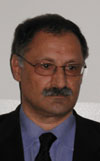Invited Talk by Prof. Franjo Pernu, PhD
Mining Medical Data
Abstract:
Medical imaging is currently undergoing rapid development with a strong emphasis being placed on the use of imaging technology to render interventions (surgery, radiotherapy, radiosurgery, biopsy, etc.) less and less invasive and to improve the accuracy with which a given intervention can be performed compared to conventional methods. In image-guided interventions, pre-intervention medical data, usually 3D computed tomography (CT) or magnetic resonance (MR) images are used to diagnose, plan, simulate, guide or otherwise assist a surgeon, radiotherapist, or possibly a robot, in performing an intervention. The plan is constructed in the coordinate system relative to pre-intervention data, while the intervention is performed in the coordinate system relative to the patient. The relationship or spatial transformation between pre-intervention data and plan and physical space occupied by the patient during intervention is established by registration. Registration, which is the crucial part of image-guided interventions, allows any 3D point defined in the pre-intervention image to be precisely located on the actual patient and may thus provide the radiotherapist valuable information about the position of the patient (tumor) or the surgeon about position of his instruments relative to the planned trajectory, nearby vulnerable structures, or the ultimate target. To be suitable for a clinical application, a registration algorithm must satisfy several requirements which concern registration accuracy, robustness, computation time, and complexity and invasiveness of intra-intervention data acquisition.
A brief overview of existing methods, three novel methods for registering 3D CT or MR images to 2D X-ray images, and quantitative registration results will be presented. The novel registration methods are based solely on the information present in 2D and 3D images. They dont require fiducial markers, intra-operative X-ray image segmentation, or construction of digitally reconstructed radiographs. The originality of the first approach is in using normals to bone surfaces, preoperatively defined in 3D MR or CT images, and gradients of intra-operative X-ray images at locations defined by rays, emitted from the X-ray source and passing through 3D surface points. The registration is concerned with finding the rigid transformation of a CT or MR volume, which provides the best match between surface normals and back projected gradients. The second method requires that first a 3D image is reconstructed from a few 2D X-ray images after which the preoperative 3D image is brought into the best possible spatial correspondence with the reconstructed image by optimizing a similarity measure. Because the quality of the reconstructed image is generally low, a novel similarity measure, which is able to cope with low image quality as well as with different imaging modalities, has been designed. The third method is an extension and improvement of the first method. The methods have been tested on two publicly available lumbar spine data with known gold standard registrations. At the end the problem of validation will be addressed and several validation issues will be demonstrated on two cases.
Biography:
Franjo Pernu received the B.Sc., M.Sc., and Ph.D. degrees in electrical engineering from the University of Ljubljana, Ljubljana, Slovenia, in 1976, 1979, and 1991, respectively. Since 1976 he is with the Department of Electrical Engineering, University of Ljubljana, where he is currently a professor and head of the Laboratory of Imaging Technologies. His research interests are in computer vision, medical imaging, and the application of pattern recognition and image processing techniques to various biomedical and industrial problems. He is (co)author of over 150 refereed scientific articles on computer vision, medical image processing and machine vision and guest editor of one journal issue. Franjo Pernu is the chairman of IAPR TC on Biomedical applications. He is co-founder of Sensum, a University of Ljubljana spin-off company, which supplies machine vision solutions.


